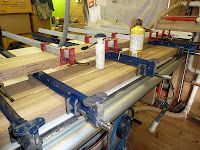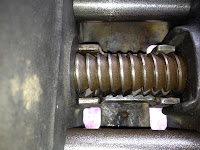Finally
after all these years, I've actually got round to starting my new
bench. It's always been on my To-do list but as many of you will know
when as you go through your married life, mortgage, kids car repairs
you know the usual, a luxury like a cabinet makers bench just gets
shoved to one side.
 |
| offcuts left for tail vices etc |
First I'll tell you
a little about the bench I intend to make, I want to keep it as
traditional as possible, but, with a difference, I am in desperate need
of tool storage space and extra vices fitted.
I
like to work around my bench from both sides and from the ends at times depending on what I'm working on. I've been pondering different the designer bench now for some time My bench will be sort of a Heinz 57 the version of some ideas pinched from them all with a few ideas of my own worked into the build as it progresses.
The new bench will have two York (tail vices) and one York shoulder vice, a
line of dog holes along both edges and possibly other dogs hole across
the benchtop for cramping purposes.
This morning I made a start and machined the core for the top, the pieces are temporarily clamped together overnight.
 |
| core boards cut marked for biscuits |
I decided to build
the top from American Oak ( just my choice) no other reason, with a
softwood base (still to be sourced), the carcase for the tools stowage
to be made out of 18mm and drawers from 12mm birch ply.
Last
week I sourced some nice American Oak pieces 2 @ 3.6m x 195mm x
80mm plenty enough to make the top from, overall sizes approximately
2m x 600mm with the core of the top is 50mm thick, the edged skirt
somewhere about 70mm to give that extra thick look, the oak arrived
yesterday.
 |
| waiting for assemble |
I
ordered the ironwork from Axminster tools for the bench, as mentioned
above but these are out of stock till next week, but, that's not the problem at the moment for me.
 |
| biscuits glued and waiting for assemble |
25/11/2012
End of day today all 264 biscuits cut machined out and ready for
glueing, I only have eight sash cramps, so I'm going to glue the core
boards up in pairs when I have three pairs all glued then I will
glue the first pair and second pair together, when they're set, I'll glue
the last pair to the first four boards this then forms the main core
to the benchtop.
 | |
| 1st boards glued |
Please note, the
biscuits cuts to the outer edge of the 1st boards this will be to glue
the skirts around the main benchtop core to house the dog holes, this I
will deal with later in the thread.
26/11/2012
Showing in the foreground the second pair just glued up on top
yesterdays pair in the background the last pair later today or early
tomorrow maybe, 22 biscuits in a double row it takes quite a lot of the pressure to cramping these together.
27/11/2012
As seen above the final pair of core boards now glue together plus
day 1 and 2 also tomorrow the final glueing to the core boards.
I'm
not going to machine the core top to its final finished level yet
till it's fixed to the base unit, I'll deal with that later in this
thread. Tomorrow I'll start machining the side skirt boards for the
dog holes etc.
First
casualty today oops, as seen in the above last photo just giving
that extra squeeze in the final cramping and ping, totally knackered
one of a set of eight, bummer Grr.
28/11/2012
Today another casualty a second clamp broke not one of those I used
yesterday but one of the heavy-duty cast-iron one as used in the lower the picture suddenly a chunk of cast iron flew off t the back end of the
shoe, it's still usable as yet not sure how badly damaged the clamp is
till I remove it tomorrow.
All
the core board to the top are now glued together, remove clamps
tomorrow and start a cutting list for the skirt and various parts for
the vices, got an email today telling there's a three-week wait for
the ironmonger on all three vices, now that could be a nuisance.
 01/12/2012 Today, ooh... it was colder in the workshop this morning than it was outside, I waiting for a few hours till the sun moved around and warmed things up a bit still cold in the workshop but not so bad when you got going. Machined the side skirts and boards for the dog hole. 02/12/2012 I machined the side skirt today, cut all mitres and machined a load more biscuit cuts, ended the day with a dry dummy run fitting the skirt boards to one side of the bench. I machined out
the groove for the tail vice guide.
01/12/2012 Today, ooh... it was colder in the workshop this morning than it was outside, I waiting for a few hours till the sun moved around and warmed things up a bit still cold in the workshop but not so bad when you got going. Machined the side skirts and boards for the dog hole. 02/12/2012 I machined the side skirt today, cut all mitres and machined a load more biscuit cuts, ended the day with a dry dummy run fitting the skirt boards to one side of the bench. I machined out
the groove for the tail vice guide.
 05/12/2012 Dry run with both side skirts fitted. Finally arrived
aboard a slow boat from china the ironwork for the three vices that will
be fitted two-tail vices and one shoulder vice for ease of use from all four sides of the bench.
05/12/2012 Dry run with both side skirts fitted. Finally arrived
aboard a slow boat from china the ironwork for the three vices that will
be fitted two-tail vices and one shoulder vice for ease of use from all four sides of the bench.
Here are both the York tail vice. I have never fitted one of these so I had better do some research first It's quite a complicated vice to manufacture and assemble, although fitting the ironwork I think should be straight forwards enough.
The Chinese engineering on these thread screws are to a very high standard I'm very impressed with them. Next to follow a shoulder vice screw thread again never fitted one but I feel it's a straight forwards to fit as well.
 Also ordered at the same time some bed furniture bolts which the photo explains what they're intended for.
Also ordered at the same time some bed furniture bolts which the photo explains what they're intended for. Ok, it's back to the workshop this afternoon after the Christmas and new year festivities.
I made as start as seen in the above photo on the bed bolts to hold the oak carrier that will do several things really ie to help hold the benchtop flat when fully glued, its primary use is to form part of the vice on the corner of the bench, as seen in the last photo it still only a dummy run, those four biscuits will be fitted above the four bolts when all is glued together I used the same centre line to line everything up nicely. I'll start on the same piece on the other end of the bench tomorrow.
As you can also see from the last photo the oak carrier has been left long, the reason being that the end will also form part of the tail vice itself, it will have a tenon cut onto it which will be running through a groove to help slide and hold in place the tail vice at the correct level/height to the bench top, (more on that later in the thread.)








































